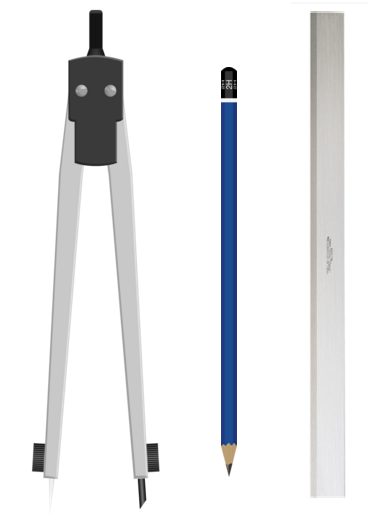Investigation: Constructions with a compass
Tools of the trade
Every profession has particular tools that they use all the time, a chef has their knives, the sewer a machine and the mathematician, well they have their construction tools.
No, not hammers and hard hats - Mathematicians use a compass, pencil and a straight edge.

From just these three things we can create (nearly) all of what we require in geometry.
Notice how I used the word straight edge and not ruler. Well that's because all we really need for the constructions is a straight edge, we often don't even need numbers!
A great Greek mathematician named Euclid, who is credited to have written the first mathematics textbook over 2000 years ago, went to great lengths to detail many of the mathematical constructions we will look at today. Geometrical constructions were so important to mathematics at the time because most problems were solved graphically, not arithmetically.
Copy a segment
To construct congruent line segments with a compass and straightedge, follow the instructions below. Play and pause the video at each step to help you.
Steps for construction
- Start with the line segment \overline{AB} on the page that you want to copy.
- Mark a point on the page where you want the start of the copied line segment. Call this point C.
- Set the compass width to the length of \overline{AB}.
- Without changing the compass width, move the compass to C.
- Draw an arc. The endpoint of the new line segment can be anywhere on the arc.
- Choose a point (D) on the arc and draw \overline{CD} with the straightedge.
Copy an angle
As we have seen, congruent means same, so congruent angles are 2 (or more) angles that are exactly the same size. They can be facing in any direction, but if they are the same size then the angles are congruent. You can think of congruent angles as copies of each other.
To construct congruent angles you need a compass and a straight edge.
Steps for construction
- Start with the angle BAC (\angle BAC) on the page that you want to copy.
- Draw a ray, \overrightarrow{PQ}, on the page.
- Position the compass on point A, adjust to any width.
- Draw an arc that crosses both legs of \angle BAC, name the points where the arc intersects the rays F and G.
- Position the compass on point on point P, and draw another arc. Where it crosses \overrightarrow{PQ} call it M.
- Measure the distance FG with the compass.
- Place the compass at point M, and cross the arc. Call this intersection N.
- Draw in a ray from P, through N. Call it \overrightarrow{PR}.
- Now you have created \angle RPQ.
- \angle RPQ \equiv \angle BAC